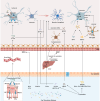Gut microbiota-astrocyte axis: new insights into age-related cognitive decline
- PMID: 38989933
- PMCID: PMC11438350
- DOI: 10.4103/NRR.NRR-D-23-01776
Gut microbiota-astrocyte axis: new insights into age-related cognitive decline
Abstract
With the rapidly aging human population, age-related cognitive decline and dementia are becoming increasingly prevalent worldwide. Aging is considered the main risk factor for cognitive decline and acts through alterations in the composition of the gut microbiota, microbial metabolites, and the functions of astrocytes. The microbiota-gut-brain axis has been the focus of multiple studies and is closely associated with cognitive function. This article provides a comprehensive review of the specific changes that occur in the composition of the gut microbiota and microbial metabolites in older individuals and discusses how the aging of astrocytes and reactive astrocytosis are closely related to age-related cognitive decline and neurodegenerative diseases. This article also summarizes the gut microbiota components that affect astrocyte function, mainly through the vagus nerve, immune responses, circadian rhythms, and microbial metabolites. Finally, this article summarizes the mechanism by which the gut microbiota-astrocyte axis plays a role in Alzheimer's and Parkinson's diseases. Our findings have revealed the critical role of the microbiota-astrocyte axis in age-related cognitive decline, aiding in a deeper understanding of potential gut microbiome-based adjuvant therapy strategies for this condition.
Copyright © 2025 Copyright: © 2025 Neural Regeneration Research.
Conflict of interest statement
Figures




Similar articles
-
Linking circadian rhythms to microbiome-gut-brain axis in aging-associated neurodegenerative diseases.Ageing Res Rev. 2022 Jun;78:101620. doi: 10.1016/j.arr.2022.101620. Epub 2022 Apr 8. Ageing Res Rev. 2022. PMID: 35405323 Review.
-
Systematic review and meta-analysis of microbiota-gut-astrocyte axis perturbation in neurodegeneration, brain injury, and mood disorders.Brain Behav Immun Health. 2025 May 12;46:101013. doi: 10.1016/j.bbih.2025.101013. eCollection 2025 Jul. Brain Behav Immun Health. 2025. PMID: 40485663 Free PMC article. Review.
-
Modulation of Gut Microbiota Through Dietary Intervention in Neuroinflammation and Alzheimer's and Parkinson's Diseases.Curr Nutr Rep. 2024 Jun;13(2):82-96. doi: 10.1007/s13668-024-00539-7. Epub 2024 Apr 23. Curr Nutr Rep. 2024. PMID: 38652236 Free PMC article. Review.
-
Microbiota-microglia connections in age-related cognition decline.Aging Cell. 2022 May;21(5):e13599. doi: 10.1111/acel.13599. Epub 2022 Mar 29. Aging Cell. 2022. PMID: 35349746 Free PMC article. Review.
-
Microbial-derived metabolites as a risk factor of age-related cognitive decline and dementia.Mol Neurodegener. 2022 Jun 17;17(1):43. doi: 10.1186/s13024-022-00548-6. Mol Neurodegener. 2022. PMID: 35715821 Free PMC article. Review.
Cited by
-
The Hidden Dangers of Sedentary Living: Insights into Molecular, Cellular, and Systemic Mechanisms.Int J Mol Sci. 2024 Oct 6;25(19):10757. doi: 10.3390/ijms251910757. Int J Mol Sci. 2024. PMID: 39409085 Free PMC article. Review.
-
Epilepsy therapy beyond neurons: Unveiling astrocytes as cellular targets.Neural Regen Res. 2026 Jan 1;21(1):23-38. doi: 10.4103/NRR.NRR-D-24-01035. Epub 2025 Jan 13. Neural Regen Res. 2026. PMID: 39819836 Free PMC article.
-
Protective Effects of Bifidobacterium Breve MCC1274 as a Novel Therapy for Alzheimer's Disease.Nutrients. 2025 Jan 31;17(3):558. doi: 10.3390/nu17030558. Nutrients. 2025. PMID: 39940416 Free PMC article. Review.
-
Gut microbiota and ovarian diseases: a new therapeutic perspective.J Ovarian Res. 2025 May 21;18(1):105. doi: 10.1186/s13048-025-01684-5. J Ovarian Res. 2025. PMID: 40399985 Free PMC article. Review.
-
Rhapontin activates nuclear factor erythroid 2-related factor 2 to ameliorate 1-methyl-4-phenyl-1,2,3,6-tetrahydropyridine-induced gastrointestinal dysfunction in Parkinson's disease mice.World J Gastroenterol. 2025 Apr 21;31(15):104875. doi: 10.3748/wjg.v31.i15.104875. World J Gastroenterol. 2025. PMID: 40309229 Free PMC article.
References
-
- Al-Mosauwi H, Ryan E, McGrane A, Riveros-Beltran S, Walpole C, Dempsey E, Courtney D, Fearon N, Winter D, Baird A, Stewart G. Differential protein abundance of a basolateral MCT1 transporter in the human gastrointestinal tract. Cell Biol Int. 2016;40:1303–1312. - PubMed
-
- Andersen JV, Schousboe A, Verkhratsky A. Astrocyte energy and neurotransmitter metabolism in Alzheimer’s disease: Integration of the glutamate/GABA-glutamine cycle. Prog Neurobiol. 2022;217:102331. - PubMed
-
- Baloni P, Funk CC, Yan J, Yurkovich JT, Kueider-Paisley A, Nho K, Heinken A, Jia W, Mahmoudiandehkordi S, Louie G, Saykin AJ, Arnold M, Kastenmüller G, Griffiths WJ, Thiele I, Kaddurah-Daouk R, Price ND. Metabolic network analysis reveals altered bile acid synthesis and metabolism in Alzheimer’s disease. Cell Rep Med. 2020;1:100138. - PMC - PubMed
LinkOut - more resources
Full Text Sources

